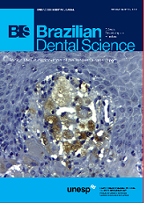Assessing different patterns of laser welding with Nickel-Chromium (Ni-Cr) alloy for structures applicable to fixed prosthesis
DOI:
https://doi.org/10.14295/bds.2017.v20i2.1363Resumo
Among all desired requirements to dental prosthesis, marginal adaptation and passive fit are the most important. In some cases, in order to achieve these goals, it is necessary to cut and weld the teeth / implant-supported framework. Nowadays, the laser welding process shows a great advantage in comparison to other methods. The aim of this study was to evaluate the optimal laser welds point that is more appropriate to Ni-Cr prosthetic framework. A total of 60 specimens of Ni-Cr (35 mm x 4 mm) were designed and welded using a Nd:YAG laser device model EV 900. They were fixed in a metal piece 0.27 mm between the ends to be welded. All specimens were welded with 21 laser pulses diametrically opposed (frequency of 1.0Hz, load time 3.0 ms and 0.5 mm of diameter pulse). They were divided into three groups according to the electric current of the laser weld: A – 180A; B – 200A and C – 220A. To determinate the flexural mechanic strength, all specimens were submitted to a three-point bending test. The results obtained were: Group A = 553 Mpa; B = 751 Mpa and C = 802.1 Mpa. The control group was 1040.9 Mpa. ANOVA and Tukey’s test were performed and statistical significance differences were observed between group A and B as well as between group A and C. However, no significant difference was observed between B and C.
Downloads
Downloads
Publicado
Como Citar
Edição
Seção
Licença
TRANSFERÊNCIA DE DIREITOS AUTORAIS E DECLARAÇÃO DE RESPONSABILIDADE
Toda a propriedade de direitos autorais do artigo "____________________________________________________________________" é transferido do autor(es) para a CIÊNCIA ODONTOLÓGICA BRASILEIRA, no caso do trabalho ser publicado. O artigo não foi publicado em outro lugar e não foi submetido simultaneamente para publicação em outra revista.
Vimos por meio deste, atestar que trabalho é original e não apresenta dados manipulados, fraude ou plágio. Fizemos contribuição científica significativa para o estudo e estamos cientes dos dados apresentados e de acordo com a versão final do artigo. Assumimos total responsabilidade pelos aspectos éticos do estudo.
Este texto deve ser impresso e assinado por todos os autores. A versão digitalizada deverá ser apresentada como arquivo suplementar durante o processo de submissão.




























